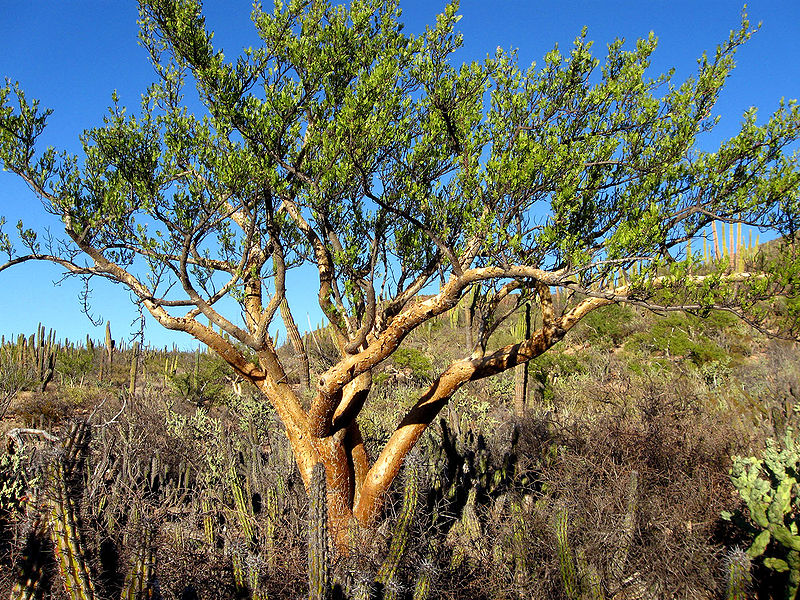

Contributor
- Topics: Archive, Plants You Need

Not a fern at all but definitely a tree, Brazilian fern tree (Schizolobium parahyba) is one of the most spectacular flowering trees in the world. Native from southern Mexico to southern Brazil, this giant member of the legume plant family is allied to both Cassia and Senna, and is impressive for its size alone. Although it is a tropical tree, it is hardier to cold than most gardeners realize and can be grown successfully in many Southern California climates where strong frosts seldom occur.
Brazilian fern tree has a dramatic growth habit, and is big in every way. Young plants have a single straight trunk that is topped by a crown of three-foot-long, bright green, doubly pinnate leaves, each composed of hundreds of half-inch to one-inch narrow leaflets, which give the effect of a large tree fern. Mature trees in the tropics may be as much as one hundred feet tall, with a thick whitish trunk that reaches thirty feet in height before it branches and a spreading canopy of foliage composed of leaves up to six feet long. These are among the largest compound leaves of any flowering tree, sometimes with over 2000 leaflets each.
The flowering of a Brazilian fern tree is as impressive as its foliage; many tall spikes of one-inch, light yellow flowers appear at the ends of the branches in spring or summer, providing a dazzling show of color against the sky. As is the case with many tropical trees, mature trees usually drop their leaves in spring just before blooming, with new leaves and flowers appearing at the same time. (Trees may also lose their leaves in response to sudden cold temperatures.) Flowering is followed by the production of four-inch-long by two-inch-wide seedpods, each containing a single large seed.
Brazilian fern tree loves summer heat and is hardier to cold than its appearance would suggest, with mature trees tolerating temperatures at least as low as 25∞ F; young trees are more tender to frost. Although it grows well in the mild coastal regions of Southern California (Sunset zones 23-24), it also thrives in the heat of our Southern California inland areas, as demonstrated by a huge specimen at the Los Angeles County Arboretum and Botanic Garden in Arcadia (Sunset zone 21). It has been noted that many trees growing in hot inland climates can withstand colder winter temperatures due to the ripening of their wood in the summer heat; this tree is reputedly being successfully grown even in desert climates such as that of Phoenix (Sunset zone 13). With adequate summer heat and water, Brazilian fern tree is extremely fast growing and can develop into a big tree in a hurry. Although cultivated trees in California may not attain the gigantic proportions of those in the tropics, they can grow as large as fifty feet tall.
Lovers of tropical trees will be happy to know that Brazilian fern tree is becoming more widely available through San Diego County nurseries and is becoming more widely grown. Although its botanical name is sometimes listed as Schizolobium parahybum, it was originally named for Brazil’s Parahyba River region (where it grows naturally), and many consider parahyba to be the preferred specific name. Beautiful flowering specimens of this tree may be seen at the San Diego Zoo in Balboa Park and at Quail Botanical Gardens in Encinitas, whose flowers are illustrated here. Although not a tree for the timid, the majestic Brazilian fern tree is a must for every tropical plant enthusiast—and is most definitely “a tree to look up to!”
Share:
Social Media
Garden Futurist Podcast
Most Popular
Videos
Topics
Related Posts

Ground Up Science for Greener Cities with Garden Futurist Dr. Alessandro Ossola
Spring 2023 Listen to the Podcast here. Alessandro Ossola is a scientist who gets very excited about the challenge of climate change allowing for an

Readying Urban Forests for Climate Realities with Garden Futurist Dr. Greg McPherson
Winter 2023 Listen to the Podcast here. “Going from the mow and blow to a more horticulturally knowledgeable approach to maintaining the landscape. And that

Welcome, Greywater, to the Garden
Summer 2022 Oh, summer: delightful warm air, tomatoes swelling on the vine, fragrant blooms on an evening stroll. When it’s warm and rainless, how is

Big Tree-Data and Big-Tree Data with Garden Futurist Matt Ritter
Summer 2022 Listen to the full Garden Futurist: Episode XV podcast here. We are in an environmental crisis right now in many parts of California








Responses